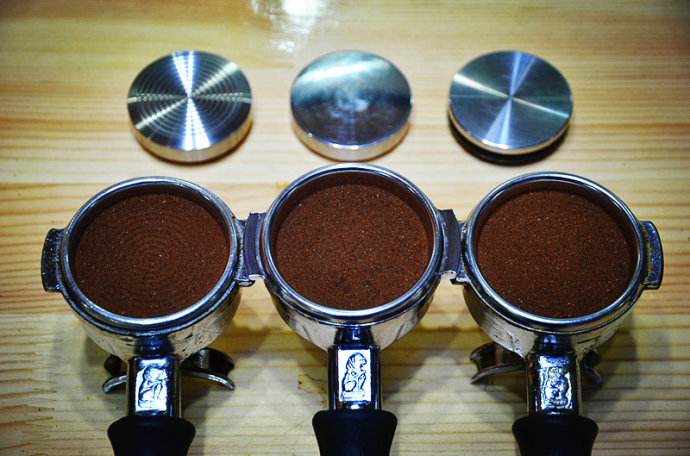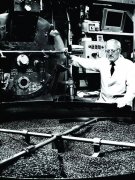Why does Espresso press powder? Light pressure or heavy pressure?

First of all, before we figure out why we need powder.
Let's talk about the extraction principle of espresso first, because many old drivers haven't figured it out yet.
One of the biggest differences between espresso and other coffee is coffee fat.
The concentration of espresso is different from that of other coffee, reaching about 10% of the coffee concentration, so then there are coffee oils that other coffees do not have.
And the concentration, we use ice drop coffee extraction method, adjust the flow rate and powder thickness can reach close to the concentration, of course, so is the Philharmonic pressure.
As for grease, only Italian can get such uniform and fragrant grease.
In coffee making, the only ones that can produce oil are mocha pots and Italian machines. The former is extremely unstable.
The latter, due to its stability, strong oil and thick taste, steadily dominate the way coffee is made.
Why can only Italian machines produce so much grease?
First of all, please buckle up your powder bowl, you will see the small hole in the powder bowl, in fact, it is not a straight up and down state.
Each hole in the powder bowl is in the shape of an hourglass, and coffee grease is actually derived from the strange design of these holes.
It is well known that coffee oil is an insoluble substance in coffee, and the traditional way of making this substance must not come out.
So, I don't know whether the maker of the machine deliberately designed it or happened to catch up with it, and made this kind of powder bowl with hourglass aperture.
As a result, when the water passes through this hole, it produces a pressurized reaction.
Espresso is extracted at nine atmospheres, and when passing through the hourglass aperture, the upper part of the pore diameter is wide and narrow, resulting in an increase in the pressure on the water. At this time, the water passes through the middle part of the hourglass and reaches the lower part. So at this time, because of the air pressure on the upper part, the air pressure is removed when passing through the state. Due to the previous pressure is too large, the discharge pressure is reduced to less than 1 atmospheric pressure, at this time, because the pressure is already lower than the normal atmospheric level. The boiling point of water actually decreases, causing water to boil at a low temperature as it passes through this funnel hole.
As we all know, water boiling is an endothermic reaction. It is necessary to absorb the heat energy of the surrounding environment in order to maintain heat absorption.
As a result, the calories in the coffee are channelled into the water that passes through the coffee.
In this case, the water-soluble substances are naturally integrated into the water, while the substances insoluble in water are brought into the coffee cup by this low-temperature boiling endothermic phenomenon.
So, when you make coffee, you will find that the grease always comes out first, the color is stronger, and the later, the whiter.
In fact, the adjustment of the thickness of the powder is to control the time when the water passes through the hourglass shape, and the pressure of 9bar is to create a suitable air pressure when the water passes through the pore diameter to maintain the boiling state of the water at a low temperature.
So, after we understand this principle first, we can actually explain why the pressure of 9bar is needed in the espresso extraction, and why it takes how many seconds to complete the extraction. And why the deep-roasted espresso oil is good, while the shallow-baked oil is poor.
And what does this have to do with the strength of your powder pressing?
Well, this is simple to talk about. The thickness of the powder controls the speed at which water passes through the coffee powder, and in the case of the same thickness of the powder, different states of the powder layer will produce different passing speeds.
For example:
The action of beating powder, beating powder will make the fine powder sink, and the distribution of coffee powder will be more hierarchical, coarse at the top and thin at the bottom.
And knock too much, even if the same thickness, the flow rate will become slower, fine powder accumulates at the bottom, the resistance becomes greater.
And the strength of the powder is a factor that determines that the water stays and then the coffee powder is of the same thickness. It does not determine the overall flow rate.
This is not easy to understand.
According to common sense, the greater the pressure, the stronger the pressure.
The actual coffee beans are naturally distributed and pressed after grinding, and the structure of the powder layer is not changed. Can only change the surface state of coffee powder.
Then why press it? Here I say that the extraction of espresso cannot be uniform. Because the water will always find a place with relatively little resistance to go down.
At present, no bean grinder is absolutely uniform, all relatively uniform.
Therefore, to press this action is actually to let her stay longer on the surface, so that the surface resistance is close to the same, so that the coffee can be extracted more evenly.
In addition: another is to turn the handle when pressing powder.
This has forgotten which American has proved that rotating when pressing powder can change the structure of the powder layer.
It can make the powder stick together more closely to improve the water resistance of the coffee powder layer.
The beans are ground to Italian thickness, and the appearance of the powder is more irregular. Give it a rotating drive on the surface, and the powder that fits each other will get stuck in one place, resulting in increased resistance to water, making it more uniform when it passes through coffee.
So, do you think pressing powder is useful? I say it is useful to increase the time for the water to stay on the surface of the coffee.
But please think of this as a variable.
Instead of a fixed value, pressing strength, and beating powder, and thickness adjustment, are actually variables.
Baristas are actually people who adjust variables in order to make coffee delicious.
Don't be killed by the variable box.
Important Notice :
前街咖啡 FrontStreet Coffee has moved to new addredd:
FrontStreet Coffee Address: 315,Donghua East Road,GuangZhou
Tel:020 38364473
- Prev

Tiffany Coffee
Although Difenuo Coffee has not been settled in China for a long time, it has been recognized and praised by the industry and the public soon because of its high quality and its world-famous brand. And its coffee spirit is to make every cup of coffee with your heart. Founder Mr. Giuseppe, an Australian local brand founded in 1947, has passed on to the third generation and is one of the top four coffee brands in Australia. Its formula.
- Next

On several sins of Coffee in Cancer Circle
[abstract] from reducing the risk of death, to reducing the risk of some cancers and diabetes, to reducing the risk of depression and Parkinson's disease. Coffee seems to have become the darling of medicine. From reducing the risk of death to reducing the risk of some cancers and diabetes, to reducing the risk of depression and Parkinson's disease. Coffee seems to have become the darling of medicine. Today, let's take an inventory of the researchers.
Related
- What brand of black coffee is the most authentic and delicious? what are the characteristics of the flavor of the authentic Rose Summer Black Coffee?
- Introduction to the principle and characteristics of the correct use of mocha pot A detailed course of mocha pot brewing coffee is described in five steps.
- Which is better, decaf or regular coffee? how is decaf made?
- How much is a bag of four cat coffee?
- How about four Cat Coffee or Nestle Coffee? why is it a cheap scam?
- Which is better, Yunnan four Cats Coffee or Nestle Coffee? How about cat coffee? is it a fake scam? why is it so cheap?
- How about Cat Coffee? what grade is a hoax? which instant coffee tastes better, four Cat Coffee, Nestle Coffee or G7 coffee?
- Process flow chart of coffee making-Starbucks coffee making process what coffee tastes good at Starbucks
- The top ten best coffee beans in the world Rose summer coffee or Tanzanian coffee tastes good
- Yunnan four cat coffee is good to drink?_four cat coffee is a big brand? four cat blue mountain coffee is fake?

